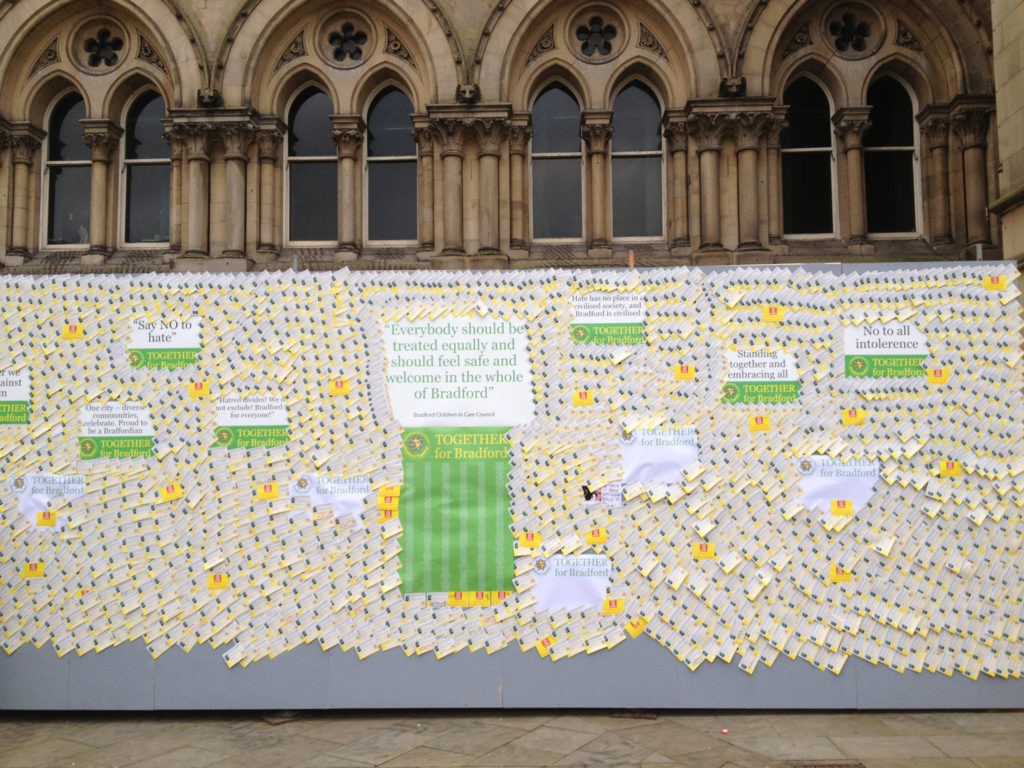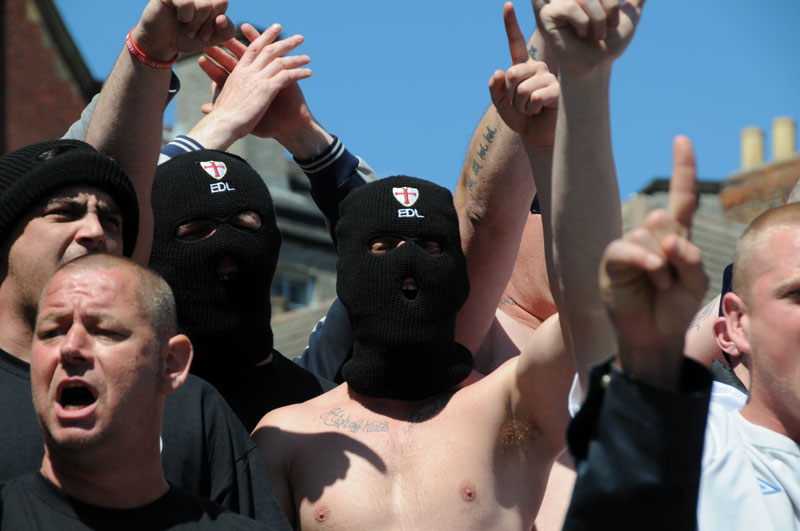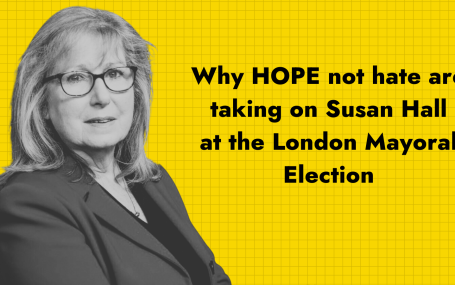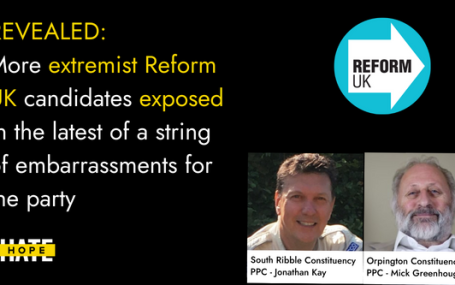HOPE not hate uses cookies to collect information and give you a more personalised experience on our site. You can find more information in our privacy policy. To agree to this, please click accept.
IT WAS the demonstration we had long feared. The English Defence League (EDL) had marched and protested its way across Britain but Bradford was always going to be our biggest test. Even the EDL described it as “The Big One” and it was not wrong.
Bradford has a population of around 300,000 and a history steeped in textiles, once even earning itself the title of “wool capital of the world”.
Unfortunately, in more recent times it has been better known for the riots that tore the city apart in July 2001, which saw over 200 local Muslim men imprisoned, the legacy of which still divides and haunts its people.
Nearly 30% of the city’s population is Muslim and like in many northern towns and cities there have been tensions and divisions. This was of course what the EDL wanted to exploit.
We knew that the EDL had to be opposed and more importantly we had to stop them provoking another riot in the city. Their intended aim was clear from the decision to apply for a march through West Bowling, a predominantly Asian area, into the centre.

From the moment we learnt this we knew our top priority was to get the march banned. But at the same time we knew that we had to have the buy-in from local people to prevent the EDL from portraying themselves as the victims of the establishment.
While we privately lobbied the council and the police we also set about winning over the local population. We established ‘Bradford Together’ and launched a huge local petition which encouraged the police and local council to apply for a ban.
The origins of Bradford Together had been laid in years of campaigning by Bradford TUC and HOPE not hate, which combined grassroots community organising and utilising innovative internet-based campaigning.
The campaign was successful because it was directed and informed primarily by local sentiment and knowledge. This localised approach meant that Bradfordians got hold of this campaign and drove it forward. They worked hard for it because they believed in it, felt some ownership and were proud of it.
We knew instantly that there was little appetite for a counter-demonstration because of a fear of a repeat of the 2001 disorder. We understood that some people wanted to show their opposition to the EDL but we believed it had to be done in a non-confrontational way, so a peace vigil was organised the day before.
The Bradford Together initiative engaged with real people in real communities in a way that a counter-demonstration, penned in by the police, was never going to do. The petition helped show the strength of local opposition to the EDL march but it also enabled us to engage with local people.
And in our petition we not only called for a ban but defended and promoted our Bradford – tolerant, multiracial and peaceful. An initial email went out to our Bradford supporters and within 48 hours our petition had gathered over 1,000 names. People passed the email on to friends, neighbours and colleagues and soon we had passed 3,000.
However, we knew we needed to do more. The Bishop of Bradford’s office circulated the petition to churches, as did the Muslim community to mosques and the voluntary sector through its networks.

Soon, hundreds of cards started to come back from all over the city, including over 500 from Buttershaw estate, an almost all-white area once targeted by the BNP. It was now time to take the campaign to the streets. Over 80 turned out on our first street petition, many getting involved for the first time. The response was amazing, with people only too happy to stop and sign.
From this point the campaign really took off. Community groups, church groups and mosques all held sign-up events and every day brought bulging post bags of yet more signatures from across the city. In three weeks we had collected almost 11,000 signatures, 6% of all adults in the city, no mean feat given our timescale and school holidays. More importantly, this was 11,000 successful conversations with local people.
One of our most important partners was the local newspaper, the Telegraph and Argus. Naturally conservative and usually shy of engaging in local politics, the newspaper’s editor quickly understood what was at stake. The newspaper ran daily stories in the fortnight leading up to the planned EDL demo, both highlighting the potential threat of violence but also covering more positive stories about how the people of Bradford were coming together in opposition.
The support of the newspaper was phenomenal. It promoted our call for a ban and it gave our campaign a huge amount of legitimacy, not only in the eyes of the public but also with key strategic partners. Crucially, the paper spoke to an older, white audience which polling suggested was the most likely to have negative attitudes to Muslims and multiculturalism. The vast majority of the 1,500 names for the petition which came through the paper appeared to be from older people.
We eventually presented the petition to the Home Office, and after additional representation from West Yorkshire police and Bradford Council, it banned the EDL march. The people of Bradford had spoken and had been heard.
The ban stopped a march but the EDL was allowed to hold a static demonstration. Again, we strongly opposed a counter-demonstration and made that point publicly, but we did support a number of events across the city to positively bring people together in the days either side of the protest.
A local women’s group dressed the city centre with peace ribbons, while HOPE not hate organised a peace vigil which was attended by over 400 people on the eve of the EDL protest. The veteran civil rights’ anthem “We Shall Overcome” become our adopted campaign song and hundreds of local people were encouraged to send in photos of themselves with the word “Together” written on their hands.
The result of all these initiatives was that the people of Bradford came together against the hatred of the EDL and it fundamentally changed the mood in the city.
This was captured in an article in a front page editorial in the Telegraph & Argus.
“In their stupidity and their naivety [the EDL] succeeded in doing exactly the opposite of what they intended: they united the people of Bradford of all colours, creeds, races and religions as one.”
“Perhaps even more importantly they helped our city to lay to rest some of the ghosts of the riots of 2001. They helped prove that Bradford has moved on, it has grown to a point where it can acknowledge and deal with its differences without the need for confrontation and violence.”
But it was the delivery of hundreds of samosas to the local police station by an assortment of local restaurateurs on the night of the EDL protest that really encapsulated the mood of the times. The threat of far-right extremism and violence really had brought the communities of Bradford together.


HOPE not hate reveals two more extremist candidates from Reform UK, in the latest of a string of embarrassments for the party UPDATE: Just hours…